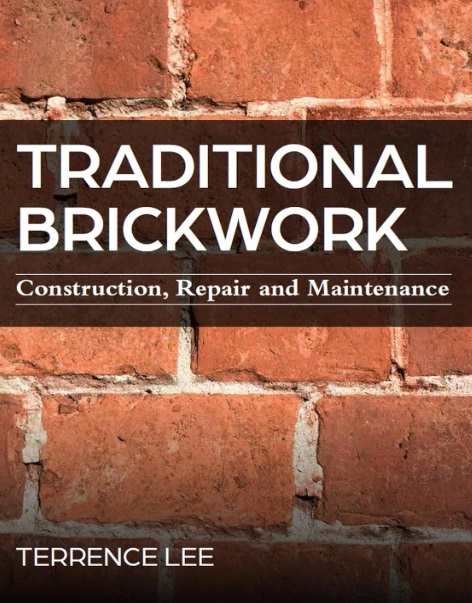Traditional Brickwork: construction, repair and maintenance
Traditional Brickwork: construction, repair and maintenance, Terrence Lee, Crowood Press, 2022, 192 pages, over 400 colour and black-and- white illustrations, paperback.
This academic but practical book follows on neatly from the review of two books in Context 176: Nicholas Barbon: developing London 1667–1698 and Bricks of Victorian London: a social and economic history.
Lee teaches, trains and lectures in the field of traditional brickwork, and carries out practical brickwork conservation projects. As a conservation bricklayer, he concentrates on handmade, low-fired brick and lime mortars, so does not venture into the realm of machine-cut, high-fired bricks and Portland cement. The first three chapters of the book describe the types, manufacture and characteristics of traditional brick until the end of the 18th century. They are very useful as a background to all brick construction until industrialisation, and the use of new forms of binder on the high-fired manufactured brick.
The first chapter describes types and sizes of brick up to the end of the 18th century, with an emphasis on bonds and different pointing and jointing, the colours of brick and methods of construction. Each example is accompanied by an excellent illustration – either a photograph or a line drawing. The second chapter covers the actual methods of manufacture, including ground moulding, bench moulding, slop moulding and sand moulding. The innovation of the ‘frog’ is described and illustrated, followed by different methods of firing bricks, with marvellously clear contemporary illustrations from L’Art du Tuilier et du Briquetier (1763).
The characteristics of traditional brick are described in the third chapter as a guide to dating brick through size, colour and scrutiny of surface markings. Chapter 4 covers the knowledge and skills required for the conservation of brickwork, including illustrated examples of poorly executed work, and explores the philosophical conflict between ‘authenticity’ and functional repair from the point of view of the craftsperson/ conservator.
The hand of a master craftsman follows in the description of tools and equipment. Jointing and pointing, accurate measuring and cutting, and a variety of tools used in bricklaying are described and illustrated. Those needed for gauged brickwork – the investment of a lifetime – are shown with clarity. Lee ventures into power tools that can assist the process, such as electric whisks and hammer drills. Materials used in brickwork come next, including a long section on the varieties of lime, their availability and suitability. The chapter ends with an assessment of pigments and pozzolanic additives.
Other chapters feature a well-constructed table on the assessment of traditional brickwork, the vulnerability inherent in brickwork – both in manufacture and construction – and a practical guide to construction and repair. The comprehensive step-by-step guide is easy to follow through the clarity of the photographs. The skill and technique required for accurate construction of gauged arches is the subject of Chapter 10, which includes the rubbing of bricks to form voussoirs. Also included are the functional and decorative methods of pointing, colour washing and the Frenchman pointing tool, followed by guidance on the maintenance of traditional brickwork, including a table of troubleshooting. The volume ends with two very helpful sections: a timeline of brickwork between the 11th and 18th centuries, and a glossary of terms relating to construction, materials, tools, and techniques.
Throughout the book, Lee’s own practical and academic knowledge shine through, making this a descriptive and easy-to-use guide that should be well-thumbed by all conservation professionals and conservation craftspeople.
This article originally appeared as ‘Master craftsman’ in the Institute of Historic Building Conservation’s (IHBC’s) Context 179, published in March 2024. It was written by Harriet Devlin.
--Institute of Historic Building Conservation
Related articles on Designing Buildings Conservation.
IHBC NewsBlog
SAVE celebrates 50 years of campaigning 1975-2025
SAVE Britain’s Heritage has announced events across the country to celebrate bringing new life to remarkable buildings.
IHBC Annual School 2025 - Shrewsbury 12-14 June
Themed Heritage in Context – Value: Plan: Change, join in-person or online.
200th Anniversary Celebration of the Modern Railway Planned
The Stockton & Darlington Railway opened on September 27, 1825.
Competence Framework Launched for Sustainability in the Built Environment
The Construction Industry Council (CIC) and the Edge have jointly published the framework.
Historic England Launches Wellbeing Strategy for Heritage
Whether through visiting, volunteering, learning or creative practice, engaging with heritage can strengthen confidence, resilience, hope and social connections.
National Trust for Canada’s Review of 2024
Great Saves & Worst Losses Highlighted
IHBC's SelfStarter Website Undergoes Refresh
New updates and resources for emerging conservation professionals.
‘Behind the Scenes’ podcast on St. Pauls Cathedral Published
Experience the inside track on one of the world’s best known places of worship and visitor attractions.
National Audit Office (NAO) says Government building maintenance backlog is at least £49 billion
The public spending watchdog will need to consider the best way to manage its assets to bring property condition to a satisfactory level.
IHBC Publishes C182 focused on Heating and Ventilation
The latest issue of Context explores sustainable heating for listed buildings and more.

















